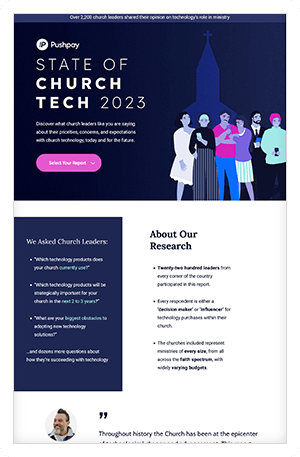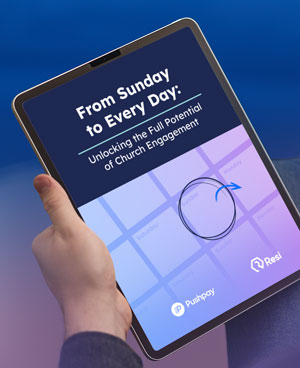5 Ways to Conquer Fears of Online Church Services
August 23, 2023 |
Change isn’t always a challenge to overcome; it’s often an opportunity to seize. And after (at least) a few years of online church, it’s clear that this opportunity wasn’t short-term. Online church brings possibilities of a wider reach, enhanced engagement, and limitless opportunities to touch lives.
But it’s natural for change to also spark some fears and concerns.
We’re addressing five common fears pastors have about online church and sharing practical solutions to help you confidently engage your congregation, no matter where they are.

Addressing the Concerns with Online Church
It’s true nothing can quite replace the warmth of a handshake or the comfort of a shared smile. And that could be a concern you have about online church.
But the hybrid model is here to stay. And the statistics prove it:
Our 2023 State of Church Tech Report found that a whopping 89% of churches now use a fully hybrid model, offering both in-person and online options,. Lifeway Research found that 45% of Americans have watched a Christian church service online—and they’re doing more than just watching a single service. The Church Online reported that one-third of churchgoers first found their current churches online. And Barna revealed that 60% of Christians were likely to continue attending church if it was solely online.
State of
Church Tech
Discover what church leaders like you are saying about their priorities, concerns, and expectations with church technology, today and for the future.

It’s time to view the concerns about online church as opportunities to grow instead of reasons to reject.
Let’s dive into 5 of the most common fears and get solutions to help you make the most of your digital ministry.
Concern 1: How Can We Connect Our Two Audiences?
One of the key challenges is engaging two distinct groups—one in the pews and one online—so that they feel like one connected congregation.
A recent Pew Research study revealed that nearly two-thirds of in-person attendees felt strongly connected with fellow churchgoers. Only 28% felt a similar bond while attending services virtually.
So how can you nurture a sense of togetherness among your two audiences? It could start with a video call for online attendees to connect before or after service. Think of it as the digital equivalent of that fellowship sipping coffee in the lobby and talking with other families.
But what about your in-person attendees? It’s crucial they know they’re not obligated to attend physically every time. They should be aware of the flexibility of attending virtually if they can’t make it in person. Share your online options in emails, on your website, social media and even from the stage so everyone knows about it.
Another way to connect your audiences is by showing them that online or in-person, they have a lot in common. One easy way to do that is to share testimonials from people in your congregation. Whether it’s a social media post or a live interview on Sunday morning, you can help members get to know fellow congregants and find common ground.
One of the beautiful things about the Church is that no matter how people attend—online or in-person—everyone is on a spiritual journey together. The moments of worship, prayer, communion, and fellowship are all shared experiences, regardless of where the audience is sitting. At the heart of it all is people seeking or strengthening their relationships with Jesus. It’s this common desire that truly bridges the gap between the physical and the virtual.

Concern 2: How Do We Keep the Personal Touch in a Digital World?
In person, it’s easy to see the light bulb moment on a congregant’s face during a sermon or the passion as they sing their hearts out during worship. You can greet them by name, give them a handshake, a smile, or even a hug.
Thanks to technology, reaching people is simpler than ever, but personal connection can feel harder to come by. Jordan Page, IT director at Higher Dimension Church in Houston, shared that they aim to be both high-tech and high-touch. Their secret? Using data.
Jordan elaborated that data and analytics play a crucial role in personalizing follow-ups. Using their ChMS, they track attendance and identify new visitors interested in learning more about the local church or regulars who have been absent from service lately.
Ultimately, small gestures can create big connections. You could send personalized thank you emails after a donation tailored to the donor or the fund they’ve given. Another way to keep online church feeling personalized is a quick email or text from the pastor on a member’s birthday.
But what about spiritual decisions or the decision to become a church member? That is a moment to celebrate. A personalized note or a shout-out during an online service can be a powerful acknowledgment of their faith journey.
With technology, you can extend the warmth and personal touch of in-person church to your virtual congregation. It’s all about making everyone feel part of your community, wherever they are.

Concern 3: How Can We Improve Engagement So It’s Ongoing?
Churches want to make sure their digital audience doesn’t just watch the service—they engage with it. Pew Research found that while most feel engaged, 32% of online attendees feel they aren’t “truly being an active participant.”
So how do you make sure your church’s online experience is engaging?
It’s important to create a sense of community—not just on Sundays but throughout the week. Our State of Church Tech Report revealed that most churches use social media (93%) and livestreaming (89%). Those are both great tools, but we’re guessing you’re looking for some other fresh ideas to foster engagement.
You can engage with members by continuing conversations throughout the week. Share discussion questions in groups or bible studies that meet outside of Sunday services. Or set up a midweek message to expand on Sunday’s topic and answer questions that have bubbled up since then.
We’ve got even more ideas to maximize your ministry’s engagement every day of the week with our ebook, More Than Sunday: Unlock Your Ministry’s Full Potential.
From Sunday to Every Day
From Sunday to Every Day: Unlocking the Full Potential of Church Engagement

If creating a fresh midweek message feels like a tall order, there’s no need to worry. You have a wealth of content at your fingertips from your weekend livestream. Short one-to-two minute clips are great bite-sized pieces of your message to share on our website, YouTube, and social media. It’s a simple but powerful way to keep the lines of communication open with your congregants, ensuring their engagement remains high throughout the week.
Learn more about Resi’s church livestreaming
Whatever method you use, the most important thing is to create spaces for connection and community throughout the week. And make it known if there’s an open line of communication between them and their pastor too.
And for those members looking for more, help them move through a discipleship journey. An easy way to help them get involved is by serving. If you don’t already have one, create an online volunteer team to encourage members to make a difference, no matter where they are. They could lead groups for online attendees, serve as greeters in the livestream chat, or join the prayer team.

Concern 4: Can We Count on Consistent Giving Online?
Okay, let’s talk about the elephant in the room—giving. It’s a crucial part of keeping churches running. And with online church, there might be concerns about what happens to the physical ‘passing of the plate.’
Here are some stats to ease that worry. Barna found that nearly half of Americans (44%) prefer digital forms of giving, and Nonprofit Source reported that 60% are willing to give to their church digitally.
Online giving certainly isn’t new, and platforms have made it easier than ever for members to contribute, no matter where they are. Digital giving has been on the rise for years, and fewer people are carrying around cash or checks. And since it’s been around, online giving providers have had plenty of time to refine it. At Pushpay, we’ve even developed innovative features that help save your church money in the long run.
But the online giving experience doesn’t end after your donor clicks that button. With our donor management, you can easily track online donations, maintain clear communication with your donors, send personalized thank-you notes, and even get an Instant view of new, repeat, recurring, at-risk and lapsed donors. This level of insight and interaction helps you grow giving and member engagement throughout their journey, so no one falls through the cracks.

Concern 5: How Can We Stay Ahead of the Fast-Paced Technological Changes?
Ever felt like technology is moving at warp speed, leaving you panting and puffing in its dust? Not to mention, spotting tech trends probably wasn’t something you studied in seminary or thought you’d need to do as a pastor.
But staying ahead of the tech game is essential to ensure your church takes advantage of all the opportunities out there. Rather than trying to do it alone, look for ways to partner with others in the tech space. Talk with tech-savvy congregation members and other church leaders with similar needs and goals. If you have enough people interested, you could even form a volunteer team or group. If, however, you’re struggling to find tech-savvy members, millions of articles are only a click away, written by fellow church leaders and church tech experts. You might find new tools to use, resources that inspire you, or a new way to use something you already have.
Start with what you’re comfortable with. Lean on the experts around you (or online), and then expand your tech toolbox as needs arise in your church. It’s not about having the flashiest tech or the most tools and software. It’s about using what you have to connect and engage with your congregation effectively.
Not sure how your church tech stacks up to other churches like yours? Take seven minutes to complete our free Church Tech Check assessment. You’ll get a free comprehensive tech evaluation unique to your ministry when you’re done.
Church Tech Check
This proprietary online assessment helps churches understand how they rank in regards to what tech they use and how they use it.

Let’s Unlock The Potential of Online Church
The digital age has opened up a whole new world of possibilities for churches to share the gospel, reach more people, and keep their members engaged. With these strategies, churches can keep their congregation connected whether they’re gathering face-to-face or streaming on a screen.
At Pushpay, we see endless opportunities in the online space for churches. We aim to help them achieve their mission with new and innovative solutions. Take the self-guided tour to find out how we can help you create a vibrant community—online and off.
Featured Content
You May Also Like
